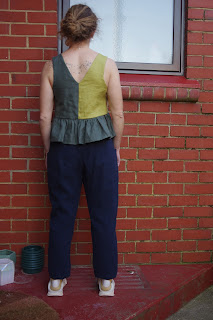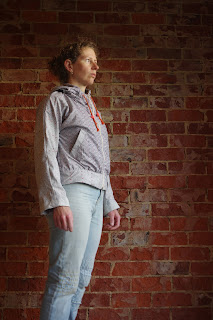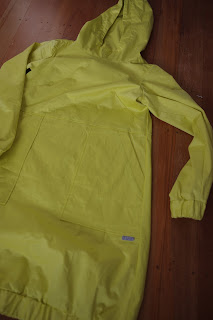I've been planning to make this ever since it came out. I have a large queue of jackets, you see, and each time I make one I need to recover afterwards. A nice jacket has a lot of small details, and all that sums up into a Big Project. For some reason it also seems like it's really hard to produce a jacket pattern that is both a good jacket, and that has good, genuinely helpful instructions. Thus, the queue just stays the same length no matter what I do!
There was the Glide jacket, by Made it Patterns. No comment. (I think I have said enough.)
And there was the Arare jacket: beautiful, success, really a bit too small considering my claustrophobia putting things over my head, but definitely a keeper. Pocket instructions a bit bad for Waffle patterns, but everything else was great.
I tried Very Hard to make the Wheaton pattern fit on a piece of waxed cotton at some point last year. A meter piece. It didn't fit, but left me the legacy of my pieces cut out in a size 0 when I'm a 4 on the size chart. Right. So then Tessa and I went to buy fabric in Auckland and got matching nylon to make matching Wheaton windbreakers. We got 3m each. And even better - when I had a reason to come up to Hamilton for sewing day, we decided to make them together.
Tessa made size 12, as she was between 10 and 12 on the chart. She reported a size 10 would have been fine. If you are following the size chart, the ease is generous. The size 0 fits me though I would have liked it a bit bigger, the size 4 would have indeed been optimal.
I prepped ahead of time because I couldn't bring scissors etc with me on the airplane. I cut out my size 0 pattern (sigh) and though I had wanted to use the gradient of the fabric on the cross grain I couldn't make it fit so I had to use it with the gradient going across. I had enough fabric to be a tiny bit picky, but barely. I interfaced everything per the instructions. Tessa really struggled with 3m of fabric but just barely got the entire thing cut out except the pockets.
Tessa started her jacket the morning of sewing day. She only interfaced as she went along and was less finicky with details. She quickly passed me and had finished the jacket by the end of the day, while I still had the cuffs to put on, the hem to sew, and the facings to tack down. This is the summary of the day: the more you follow these instructions, the worse things will go for you. We agreed that this was the worst sewing day we had ever had together because we were collectively miserable at every single step of the process. (Usually we are at least sewing different things and can cheerlead each other on.)
First: welts. As every pattern designer seems to think they have to reinvent the welt-wheel, these welt marks are very confusing. They are inside out arrows, instead of a box. Save yourself, and draw the box around the arrowhead ends. Then you line up the welts with the sides of your box, per usual. Also, don't fold the welt lip ahead of time, because then you're constrained to use it without adjusting it to cover the space. Wait til later when you can adjust it to fit - a better pocket results.
Next issue: interfacing. Don't interface *anything* that has go to around a curve. This pattern is drafted so tightly that it just won't go. Don't interface the hem, don't interface the neck part of the facing. If you have fabric that requires interfacing, it's worth cutting the interfacing down so it is not on the seam allowance. Tessa beat me here by only interfacing as she went along, and didn't interface things that didn't need it. She was able to ease in her hood and the hem without catastrophic amounts of seam ripping, whereas I lost a few hours undoing and getting frustrated.
Tessa:
(In these photos I still hadn't done the facings although the exterior was put together.)
Subsequent drama: the cuffs. WTF? You cut out 4 little pieces but as best we could understand, you need 8, 4 for each side. A LONG TIME after finishing the jacket I suddenly wondered if you are supposed to actually do the cuffs as a facing inside the sleeve, but that doesn't make sense because the sleeves are already super short. So, if you are doing normal cuffs you need 8 of those little pieces. Also I forget now what the instructions said but best to ignore them and do normal cuffs - attach to jacket and thread the elastic through the casing. It will save you some stress. Consider measuring the length of sleeves and lengthening if not happy - they are pretty short.
Finally if you actually sew the facing and hem facing down to hold the pocket in, you lose half the pocket. If you want full sized pockets, they have to be outside all those facings and flappy around. A peeve I have.
In summary, we both finished our jackets, although I took another month to recover from the very memory and finish mine. After taking these photos I did add elastic into the cuffs. Tessa says that she has been wearing her jacket to work every day and gets so many compliments on it, which gives her the opportunity to tell everyone how awful it was to make. I don't know if I can get over the experience and I will probably give mine to my cousin, who has asked for it. (I did, and she loves it.)
If you love the shape of the Wheaton this is the advice I can offer:
It creates a very high quality jacket though with some flappy but nice and deep pockets.
It might not be fun along the way. Do a practice welt pocket, interface only as you go and as really needed, and lengthen the sleeves ahead of time if you arms are anything longer than average or if you want to try a sleeve facing instead of a cuff. Don't plan to do it in a day or your creative vocabulary will come out! Plan bribes to get yourself through it.





























































